

|
| ČESKÁ REPUBLIKA | CZECH REPUBLIC |
| Jihomoravský kraj | South Moravia (Brno) region |
| Okres: Brno-město |
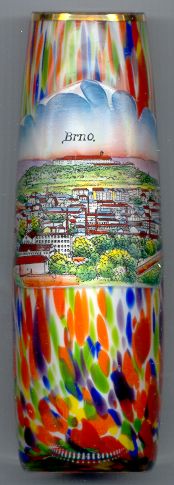 Brno is situated at an elevation of 215 m at the confluence of the Svitava and Svratka rivers. With a population
of about 367,400 (2005) is is the second-largest city of the Czech Republic. Brno is the capital of the South Moravia
region.
Brno is situated at an elevation of 215 m at the confluence of the Svitava and Svratka rivers. With a population
of about 367,400 (2005) is is the second-largest city of the Czech Republic. Brno is the capital of the South Moravia
region.
The origins of Brno go back to a castle that was founded around 1021. The earliest document mentioning the settlement dates from 1091. The town itself was founded in 1243 by Wenceslaus I of Bohemia. In 1641 it superseded Olomouc as capital of Moravia. During the Thirty Years' War (1618–1648), Brno was besieged without success by Swedish troops. In 1805 the nearby Slavkov u Brna (Austerlitz) was the site of the famous victory of Napoleon over the Austrian and Russian armies. The battle is also known as the 'Battle of Three Emperors', although only Czar Alexander I and Napoleon participated personally, Franz I of Austria (Franz II as emperor of the Holy Roman Empire) was not present in person. Since the 13th century, the population of Brno (German: Brünn) was largely German-speaking. After World War I a number of neighbouring communtiies were incorporated into the municipalty of Brno so that Czeck speakers became the majority. After World War II, on 31 May and 1 June 1945, almost all the German inhabitants (about 25% of the population of Brno at that time) were forced to leave the town and were marched off to the Austrian border, about 60 km away. Many of them died of prostration, starvation or typhoid fever.
Villa Tugendhat, designed by Mies van der Rohe and built in the late 1920s close to the centre of the city, is known as a monument of modern architecture, and was designated a World Heritage Site by UNESCO in 2001. (see also list of other UNESCO heritage sites depicted on glasses of this collection)
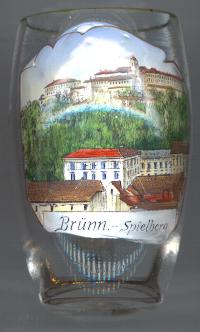
The  fortress on the Špilberk (German: Spielberg) hill was founded in the second half
of the 13th century. It became a seat of the kings of Bohemia and margraves of Moravia. In the mid-17th century it was
enlarged into a mighty fortress. Together with the fortifications of the city of Brno it was the strongest fortress of
Moravia. Under Emperor Joseph II, in 1783 and 1785, parts of the castle were converted into a prison intended for the incarceration of those who
were considered the most dangerous enemies of the country. Large parts of the fortress were demolished by French troops in 1809
so that it lost its military significance. From 1820 until 1855 it was only used as a
prison. After that, it was used as barracks and military prison for another hundred years. Extensive renovation works
in 1987–1992 aimed at restoring its state of the late 18th century.
One of the most prominent prisoners of the fortress was Franz Freiherr (Baron) von der Trenck, leader of an irregular
corps of Pandurs in Austrian service. After the peace between Austria and Bavaria in 1745, he was court-martialed
for insubordination and other offences. Von der Trenck died in the fortress in 1749.
fortress on the Špilberk (German: Spielberg) hill was founded in the second half
of the 13th century. It became a seat of the kings of Bohemia and margraves of Moravia. In the mid-17th century it was
enlarged into a mighty fortress. Together with the fortifications of the city of Brno it was the strongest fortress of
Moravia. Under Emperor Joseph II, in 1783 and 1785, parts of the castle were converted into a prison intended for the incarceration of those who
were considered the most dangerous enemies of the country. Large parts of the fortress were demolished by French troops in 1809
so that it lost its military significance. From 1820 until 1855 it was only used as a
prison. After that, it was used as barracks and military prison for another hundred years. Extensive renovation works
in 1987–1992 aimed at restoring its state of the late 18th century.
One of the most prominent prisoners of the fortress was Franz Freiherr (Baron) von der Trenck, leader of an irregular
corps of Pandurs in Austrian service. After the peace between Austria and Bavaria in 1745, he was court-martialed
for insubordination and other offences. Von der Trenck died in the fortress in 1749.
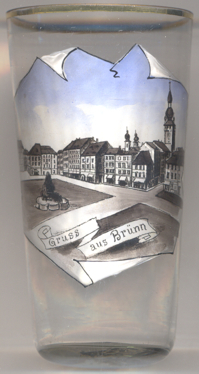 Glass no. 3137 [near left, no. 3137] shows a view of
Glass no. 3137 [near left, no. 3137] shows a view of  Zelný trh
Zelný trh kašna Parnas
kašna Parnas
[http://reisefuehrer.suedmaehren.info/krautmarkt, https://www.gotobrno.cz/de/ort/krautmarkt-zelny-trh/,
https://www.visitbrno.cz/de/brno-parnas-brunnen/25/]
The core of the  Old Town Hall with its characteristic tower [background right]
already date from around 1240, when Brno had obtained its privileges as a town. A chapel was added in 1424.
The late Gothic portal was created at the beginning of the 16th century. The town hall served as the meeting place
of the city council from 1343 until 1935.
Old Town Hall with its characteristic tower [background right]
already date from around 1240, when Brno had obtained its privileges as a town. A chapel was added in 1424.
The late Gothic portal was created at the beginning of the 16th century. The town hall served as the meeting place
of the city council from 1343 until 1935.
[https://de.wikipedia.org/wiki/Altes_Rathaus_(Brünn)]
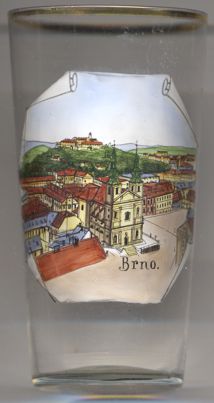 The
The  church of St. Michael [near left, no. 4532] in Dominikanské náměstí
(Dominican Square) near the New Town Hall. Its history is closely connected with the Dominican monastery – the Dominicans received the small church of St. Michael,
then later enlarged it, and even later rebuilt it in Gothic style. In the Middle Ages, the church fulfilled an important function – the provincial estates held
their councils here, and the Moravian Margraves received their official positions here. The church was destroyed during the siege of Brno by the Swedish army in 1645,
then it underwent a Baroque reconstruction from 1658 to 1679. The Dominicans were evicted from Brno following the Edict on Idle Institutions in the 1780s. From 1905
until 1950 the church was used bythe order of the Redemptorists. The church has been preserved in this form to the present day. The church is accessible to the public
only during the holy mass. SOme of the former monastery buildings serve as the New Town Hall.
church of St. Michael [near left, no. 4532] in Dominikanské náměstí
(Dominican Square) near the New Town Hall. Its history is closely connected with the Dominican monastery – the Dominicans received the small church of St. Michael,
then later enlarged it, and even later rebuilt it in Gothic style. In the Middle Ages, the church fulfilled an important function – the provincial estates held
their councils here, and the Moravian Margraves received their official positions here. The church was destroyed during the siege of Brno by the Swedish army in 1645,
then it underwent a Baroque reconstruction from 1658 to 1679. The Dominicans were evicted from Brno following the Edict on Idle Institutions in the 1780s. From 1905
until 1950 the church was used bythe order of the Redemptorists. The church has been preserved in this form to the present day. The church is accessible to the public
only during the holy mass. SOme of the former monastery buildings serve as the New Town Hall.
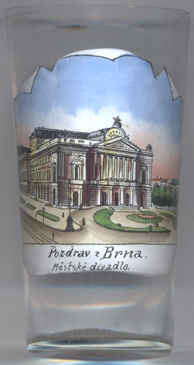
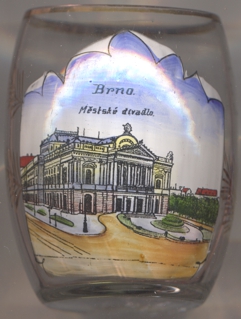
The  Mahen Theatre (Mahenský divadlo) [left, no. 3155, and right, no. 3998]
was built in 1881–1882 by the architects Ferdinand Fellner and Hermann Helmer in a combination of
Neo-renaissance, Neo-baroque and Neoclassical architectural styles as the
German Municipal Theatre (Deutsches Stadttheater).
When opened in 1882, was one of the first public buildings in the world lit entirely by electric light.
Until 1918 it operated as the German theatre, showing productions in German language,
while productions in Czech language were shown in the smaller Czech National Theatre (divadlo na Veveří).
After the dissolution of the Austrian empire in 1918 and the foundation of the Czechoslovak state, the two theatres
exchanged their roles and the larger theatre, now operating in Czech, was renamed Divadlo na Hradbách
(Theatre on the Wall) and the first dramatical adviser became the novelist and playwright Jiří Mahen,
after whom the theatre has been named since 1965. In 1936, the theatre was largely reconstructed and became one
of the most modern theatre buildings in Czechoslovakia. Until the building of Janácek Theatre in 1965
the Mahen Theatre served mainly as an opera house. Since 1965, the theatre has served as the home stage of the
dramatical ensemble of the National Theatre in Brno. Mahen Theatre was proclaimed as one of the National Technical
Monuments of the Czech Republic.
Mahen Theatre (Mahenský divadlo) [left, no. 3155, and right, no. 3998]
was built in 1881–1882 by the architects Ferdinand Fellner and Hermann Helmer in a combination of
Neo-renaissance, Neo-baroque and Neoclassical architectural styles as the
German Municipal Theatre (Deutsches Stadttheater).
When opened in 1882, was one of the first public buildings in the world lit entirely by electric light.
Until 1918 it operated as the German theatre, showing productions in German language,
while productions in Czech language were shown in the smaller Czech National Theatre (divadlo na Veveří).
After the dissolution of the Austrian empire in 1918 and the foundation of the Czechoslovak state, the two theatres
exchanged their roles and the larger theatre, now operating in Czech, was renamed Divadlo na Hradbách
(Theatre on the Wall) and the first dramatical adviser became the novelist and playwright Jiří Mahen,
after whom the theatre has been named since 1965. In 1936, the theatre was largely reconstructed and became one
of the most modern theatre buildings in Czechoslovakia. Until the building of Janácek Theatre in 1965
the Mahen Theatre served mainly as an opera house. Since 1965, the theatre has served as the home stage of the
dramatical ensemble of the National Theatre in Brno. Mahen Theatre was proclaimed as one of the National Technical
Monuments of the Czech Republic.
(See also list of other building by Fellner and Helmer depicted on
glasses in this collection.)
[https://de.wikipedia.org/wiki/Mahen-Theater, https://en.wikipedia.org/wiki/Mahen_Theatre]
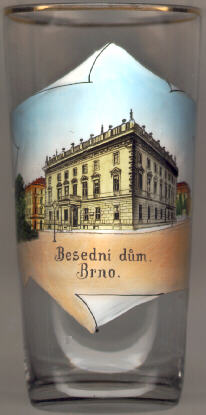
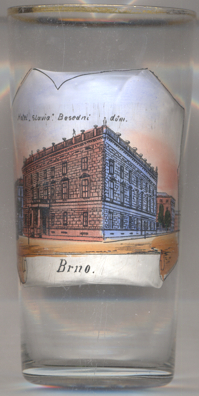
The  Besední dům ('Society House') [far left, no. 151; near left: no. 3396]
was built in 1871–1873. The building in Renaissance Revival style is the most important construction in Brno of the
architect Theophil Hansen from Vienna. Since 1956 it is home to the Brno State Philharmonic Orchestra.
Besední dům ('Society House') [far left, no. 151; near left: no. 3396]
was built in 1871–1873. The building in Renaissance Revival style is the most important construction in Brno of the
architect Theophil Hansen from Vienna. Since 1956 it is home to the Brno State Philharmonic Orchestra.
Glass no. 3396 [near left] is labeled as a souvenir from Hotel „Slavia”, which is located just to the left of Besední dům, albeit not depicted on the glass itself.
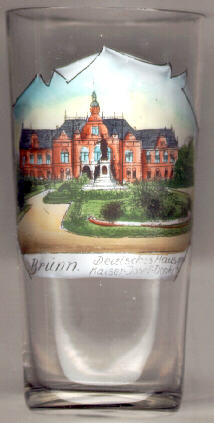
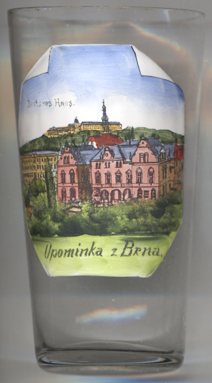
The  "Deutsches Haus" ('German House') [right, no. 4655, and far right, no. 333]
was built in 1889–1891. The brick building in German Renaissance Revival style was razed to the ground by the
Czech authorities in 1945. The site today is occupied by the public park, Moravskó náměstí
('Moravian Square'). Depicted in front of the building is the
"Deutsches Haus" ('German House') [right, no. 4655, and far right, no. 333]
was built in 1889–1891. The brick building in German Renaissance Revival style was razed to the ground by the
Czech authorities in 1945. The site today is occupied by the public park, Moravskó náměstí
('Moravian Square'). Depicted in front of the building is the  monument
monument
[https://de.wikipedia.org/wiki/Liste_der_Kaiser-Josef-II.-Denkmäler]
It is interesting that glass no. 4655 [near right] is labeled both in German and Czech: The view of the German House
is labeled in German (Deutsches Haus) whereas the labeling on the bottom is Czech (Upominka z Brna for 'souvenir from Brno').
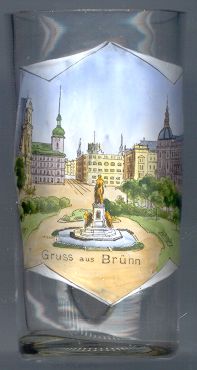
The  church of St. James [left, no. 2032: background left; the spire also
visible in the background of the pictures on glasses no. 028 and no. 4151, both below] was built in the 14th and 15th century.
The roof of the church tower was added in 1592.
church of St. James [left, no. 2032: background left; the spire also
visible in the background of the pictures on glasses no. 028 and no. 4151, both below] was built in the 14th and 15th century.
The roof of the church tower was added in 1592.
Glass no. 2032 [left] shows a view of  Lazansky Square
Lazansky Square monument
monument
[https://de.wikipedia.org/wiki/Liste_der_Kaiser-Josef-II.-Denkmäler]
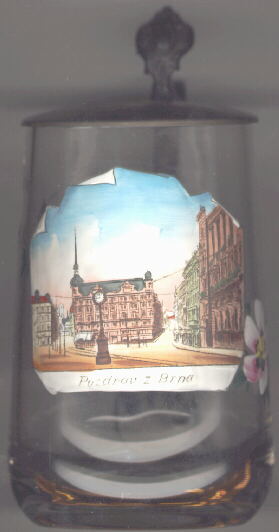
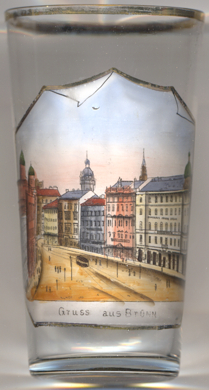
Glasses no. 028 [left], no. 4151 [below] and no. 3828 [right] show views of
 Náměstí
Náměstí
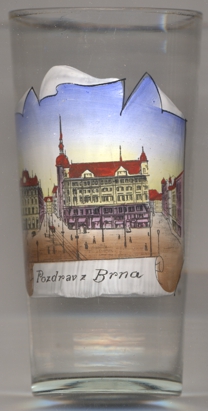
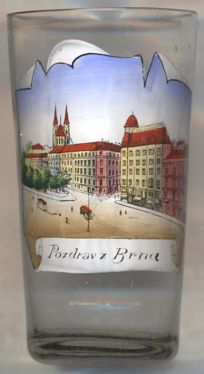
The view shown on the picture on glass no. 4485 [left] is  Nádražní
Nádražní
Depicted in the background left is the  Cathedral of St. Peter and Paul, located on the Petrov hill. The cathedral
is the seat of the diocese of Brno. The site of the Cathedral of Saints Peter and Paul has housed a church since at least the 11th and 12th centuries;
a Romanesque chapel was built there in about 1140. A larger church, possibly a Romanesque basilica with embryonic Gothic forms, was constructed there around the
1230s and dedicated to St. Peter. This, however, was damaged by a large fire that swept the city in 1368. The first documentation of the patronage of both
Saints Peter and Paul dates from 1378. The church was reconstructed again in the second quarter of the 15th century in the aftermath of the Hussite Wars, when a
presbytery and several smaller annexes were added to it, including the chapel of the Virgin Mary. From 1296 it had served as the seat of the Royal Capital Chapter
of St. Peter and Paul in Brno, a college of various monasteries. This church lasted only until 1643, when a large fire started by Swedish troops during the
Thirty Years' War (1618–1648) burnt the entire set of buildings on Petrov hill, and the church underwent subsequent rebuilding and renovations, many of which
were of the early Baroque style common at the time. The eighteenth century saw further renovations to the church take place, and in 1775–77 it became the seat of
the new Diocese of Brno. More renovations took place about a century later, when between 1879 and 1891 a new Gothic-style presbytery, chapel of the Virgin Mary,
and sacristy were constructed. The last major additions to the structure took place between 1901 and 1909, when the twin neo-Gothic towers that give the church
its present monumental character were added.
Cathedral of St. Peter and Paul, located on the Petrov hill. The cathedral
is the seat of the diocese of Brno. The site of the Cathedral of Saints Peter and Paul has housed a church since at least the 11th and 12th centuries;
a Romanesque chapel was built there in about 1140. A larger church, possibly a Romanesque basilica with embryonic Gothic forms, was constructed there around the
1230s and dedicated to St. Peter. This, however, was damaged by a large fire that swept the city in 1368. The first documentation of the patronage of both
Saints Peter and Paul dates from 1378. The church was reconstructed again in the second quarter of the 15th century in the aftermath of the Hussite Wars, when a
presbytery and several smaller annexes were added to it, including the chapel of the Virgin Mary. From 1296 it had served as the seat of the Royal Capital Chapter
of St. Peter and Paul in Brno, a college of various monasteries. This church lasted only until 1643, when a large fire started by Swedish troops during the
Thirty Years' War (1618–1648) burnt the entire set of buildings on Petrov hill, and the church underwent subsequent rebuilding and renovations, many of which
were of the early Baroque style common at the time. The eighteenth century saw further renovations to the church take place, and in 1775–77 it became the seat of
the new Diocese of Brno. More renovations took place about a century later, when between 1879 and 1891 a new Gothic-style presbytery, chapel of the Virgin Mary,
and sacristy were constructed. The last major additions to the structure took place between 1901 and 1909, when the twin neo-Gothic towers that give the church
its present monumental character were added.
[https://en.wikipedia.org/wiki/Cathedral_of_St._Peter_and_Paul,_Brno]
![[scale]](lineal.jpg)